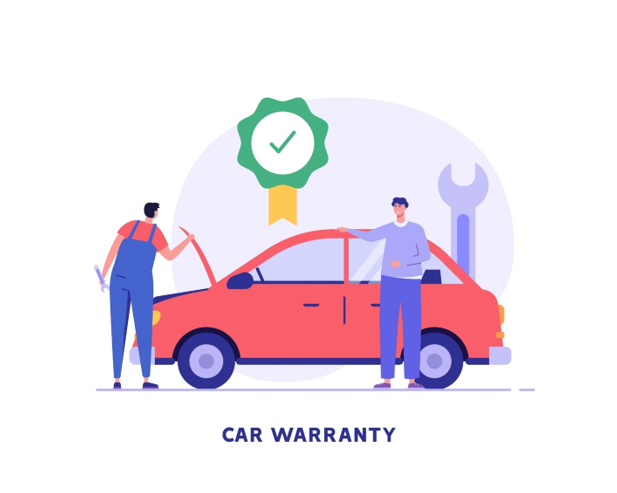
Have you ever found yourself stuck on the side of the road after your car just stopped working? Vehicle breakdowns like that can be a nightmare, especially when they happen unexpectedly. You might not know what to do, who to call first, or how much the whole ordeal will cost you.
Investing in an auto warranty can save you a lot of money and stress in the long run because you’ll feel prepared should your car need those unexpected repairs.
Still, with so many coverage options available, which plan is the right one for you? Choosing the right auto warranty for your car can be a daunting task because there are so many factors to consider.
In this article, we’ll guide you through those factors that you would consider when selecting a car warranty, such as the level of coverage, term length, cost, and reputation of the warranty provider. We can help you make an informed decision on the perfect choice for you and your vehicle.
Types of Auto Warranties
If you’ve bought a car from a dealership, chances are it has some sort of warranty coverage. Of course, the extent of that warranty will depend on whether it’s a new or pre-owned vehicle, as well as on its age and mileage. So, when would you need to buy a warranty? You could purchase this kind of added coverage at almost any stage of your vehicle’s ownership.
But, first of all, let’s take a look at the different types of warranty coverage. Auto warranties come in three main types, which are:
- Manufacturer’s warranties: These are provided by the carmaker with a new car purchase and cover defects in materials and workmanship that are discovered within a specific period and mileage amount
- Extended manufacturer’s warranties: These extend your factory warranty term and can be purchased at your dealership or through the manufacturer before the original coverage expires
- Aftermarket extended warranties: These also extend your warranty protection but are offered by third-party providers and may add coverage beyond the manufacturer’s warranty
Both types of extended warranties are an added service that is not already included with a car purchase. But where extended manufacturer’s warranties can only be bought within the first few years of a vehicle’s life and their terms and coverages are limited by the car companies, aftermarket warranties are much more flexible and customizable.
They provide different levels of coverage for used cars, even after the expiration of the manufacturer’s warranty period. An aftermarket extended auto warranty, commonly called a vehicle service contract (VSC), can last for longer periods and higher mileage limits.
You can find more information on the differences between these types of warranties here.
Length of Warranty
The term length of an auto warranty depends on its type, but it generally involves a period and a mileage limit. If you drive your vehicle over that mileage limit before the end of your warranty period, or vice versa, then your warranty protection ends.
Manufacturer warranties have two levels of coverage built-in into their terms: typically covering your car’s “bumper-to-bumper” repair needs for a limit of three years and 36,000 miles, after which you would have limited “powertrain” coverage for five years and 60,000 miles.
Extended warranties have more flexibility and can be customized to the driver’s preferred duration. You might be able to buy coverage for one to eight years. Some warranty providers may have longer-term periods of up to 10-12 years, while others might offer monthly contracts.
Many factors may go into what warranty terms are offered to you, such as your car’s make and model, age, mileage, and location. As a result, it is crucial to consider the age of your car, how long you plan on keeping it, and the distance you cover in a year. These aspects will help determine the best auto warranty that suits your car.
Coverage
Auto warranties come in different levels, or tiers, of coverage. You can have comprehensive warranties that cover almost everything, all the way down to basic part coverage. A third-party warranty provider may offer VSC plans with the following coverage categories:
- Exclusionary: This is the most like a manufacturer’s initial coverage. It is meant to provide “bumper-to-bumper” protection to all your car’s parts, with some exceptions detailed in the contract. This kind of plan would be called a company’s most comprehensive
- Comprehensive inclusionary: This type of plan lists all the vehicle parts it covers, which would include the highest number of parts categories of all the provider’s plans. A provider might also call this their top “stated coverage” plan
- Powertrain: This is usually the most basic inclusionary plan, which typically only covers the engine, transmission, and drivetrain
- Supplementary: This is added exclusionary protection on top of your current manufacturer’s powertrain warranty. Endurance offers such a plan, the Supreme Wrap plan
You should know that even within the above categories, the offered levels of coverage will vary depending on the provider. As such, it is crucial to carefully read and understand the contract’s fine print to know what is covered and what is not.
Among other things, you should consider the added benefits like roadside assistance as well as the deductible, repair limits, and exclusions before settling on a plan.
See Also: Buying a Used Car in the UK is a Smart Choice for Everyone
Cost
A warranty plan can vary in price, often depending on the age and make of the car, its intended use, the level of coverage, and claims history. Costs could also depend on whether you opt to buy coverage for a certain term period or monthly.
Many providers will not outright advertise their pricing, but you may choose to pay on a monthly installment plan or up-front for the entire contract term. If you decide on an installment plan, many providers will consider your budget and might quote lower premiums over longer payment terms.
You should consider how much you are willing to spend, the cost of repairs in the event of a breakdown, and the overall value of your car before contacting a warranty company. It’s also essential to consider all the perks you’d receive, as some providers offer extra benefits such as roadside assistance, towing services, and rental car reimbursement.
Reputation of the Provider
The reputation of the warranty provider is very significant. You might be able to find out a lot about a provider by looking into their history and the achievements and accolades they have racked up.
You might also look at their industry accreditations and customer reviews for an idea of what to expect in terms of their support and claim fulfillment records. It is also essential to ensure the provider is properly licensed and registered in your state.
So, How Do You Choose?
Ultimately, the choice falls to you and your priorities. Many reputable providers offer affordable basic coverage, and that might be enough for you if you have a high-mileage car and want coverage only for its powertrain parts.
On the other hand, you might have an electric car that is just out of its manufacturer’s coverage period, and you worry about having to repair its many high-tech parts. In that case, the cost might take a backseat to the extent of coverage and length of the term.
Popular service contract providers like Endurance and Ox Car Care offer a good range of coverage options, but many other companies could suit your needs just as well or better. You should do your research and compare between them before making your decision.







